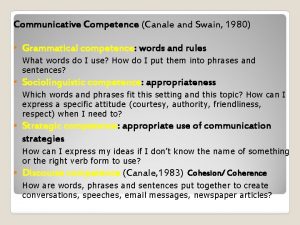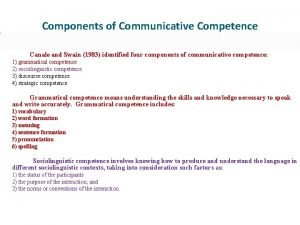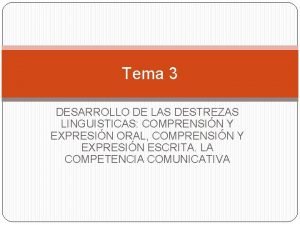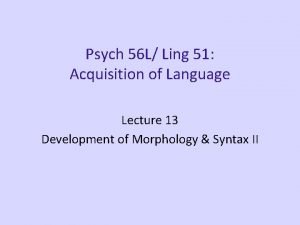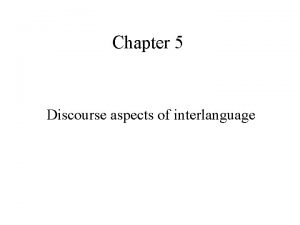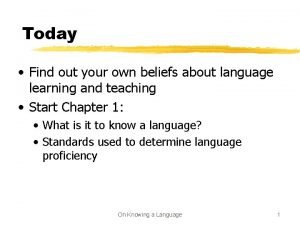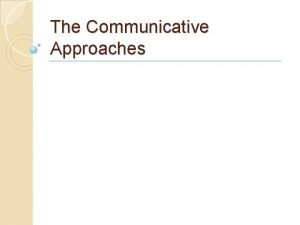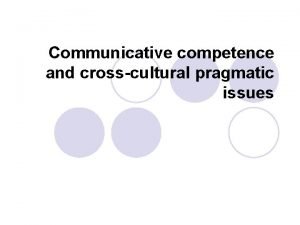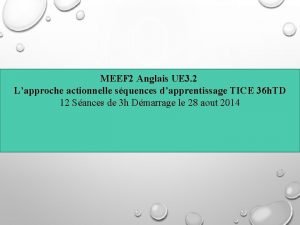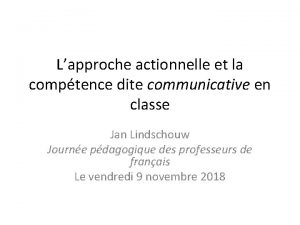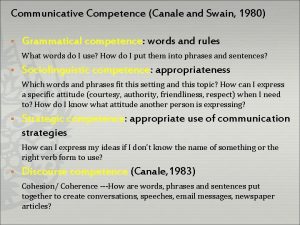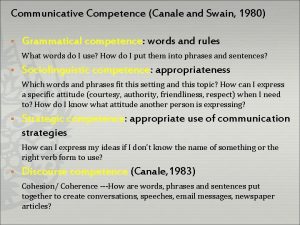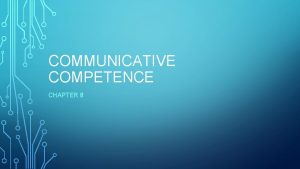Communicative Competence Canale and Swain 1980 Grammatical competence









- Slides: 9

Communicative Competence (Canale and Swain, 1980) § Grammatical competence: competence words and rules What words do I use? How do I put them into phrases and sentences? § Sociolinguistic competence: competence appropriateness Which words and phrases fit this setting and this topic? How can I express a specific attitude (courtesy, authority, friendliness, respect) when I need to? § Strategic competence: competence appropriate use of communication strategies How can I express my ideas if I don’t know the name of something or the right verb form to use? § Discourse competence (Canale, 1983) Cohesion/ Coherence How are words, phrases and sentences put together to create conversations, speeches, email messages, newspaper articles?

Communicative Language Teaching is best considered an approach rather than a method. Thus, there is much greater room for individual interpretation and variation than most methods permit (Richards and Rogers, 1986, p. 83)

Common misconceptions concerning the meaning of CLT § not teaching grammar, § teaching only speaking, § expecting too much from teachers § Fluency at the expense of accuracy

Q: Ellis (1982) suggests that the communicative activities are sufficient for acquisition to take place. What do you think?

§ Restructuring of "grammar" principally takes place when learners attend to and notice features in input (Schmidt, 1990). § For L 2 grammatical development to occur, learners must pay attention to form and notice gaps between the provisional state of their grammatical knowledge and the communicative demand of the context(Loschky and Bley. Vroman, 1993).

The idea of attention to form differs from explicit formal instruction. Long (1991) distinguishes between focus on forms and focus on form. Focus on forms---similar to traditional grammar teaching (primary purpose is to teach language forms in isolation). Focus on form--- attempts to draw the student's attention to linguistic forms as they arise in activities whose primary focus is on meaning.

Q: Are the authentic materials always good?

In an ideal communicative language teaching… § Classroom goals are focused on all of the components of communicative competence. § Language techniques are designed to engage learners in the pragmatic, authentic, functional use of language for meaningful purposes. § Fluency and accuracy are seen as complementary principles underlying communicative techniques. § Students ultimately have to use the language, productively and receptively (Brown, 1994, p. 245)

When you apply Communicative Language Teaching to your own teaching, you might want to check these out. Does the format and material of the lesson not only provide useful "input" for the learner but also lead to "output" and language production by the learner? Does the material and the format help to generate spontaneous language use that is not easily predictable? Does your lesson contain something that helps the learners to improve their generative and pragmatic competence rather than simply use fossilised resources?
 Canale swain 1980 communicative competence
Canale swain 1980 communicative competence Canale and swain's model of communicative competence
Canale and swain's model of communicative competence Destrezas lingüísticas
Destrezas lingüísticas Examples of grammatical competence
Examples of grammatical competence Examples of grammatical competence
Examples of grammatical competence Competence vs performance in linguistics
Competence vs performance in linguistics Clt topics
Clt topics Communicative competence
Communicative competence Approche actionnelle anglais
Approche actionnelle anglais La compétence communicative
La compétence communicative
